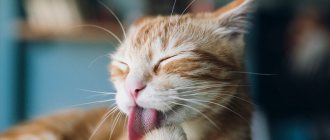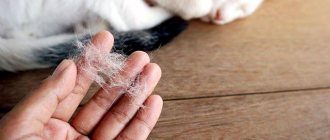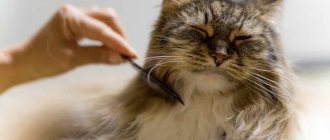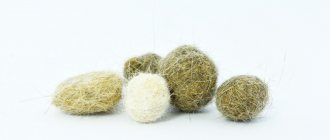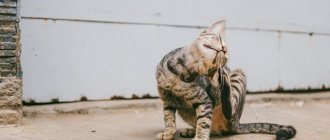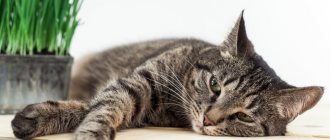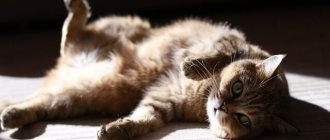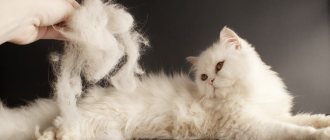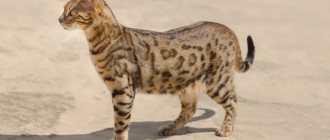If you begin to notice that your cat is losing a lot of hair, and this does not look like the usual seasonal shedding, since whole shreds end up on the bedding and floor, it means that there is something wrong with the pet, it doesn’t have enough vitamins, it has allergies and etc. Often, the fur loses its beautiful appearance, and the pet licks itself so actively that bald spots form.
Causes of hair loss in cats
Cats need fur to protect them from damage. Seasonal molting is explained by the need to adapt to the surrounding temperature. Therefore, for example, sphinxes that do not have a thick undercoat (the opinion that they have no hair at all is deeply mistaken) easily get wounds and scratches.
A cat's fur is her pride, although we, the owners, are even more proud of it. Smooth and shiny fur is an indicator of the animal’s good health, so it is not surprising that its dullness and loss makes you want to understand the reasons.
Shedding
Seasonal shedding in cats is a natural phenomenon. In the fall, your pet “changes” its fur, changing it from summer to winter. At this time, the undercoat becomes thicker, while in the spring, on the contrary, it thins out.
We also recommend reading the article about why cats shed.
The beginning of the process can also be judged by your own clothes. As soon as a cat walks near you, your trousers or dresses become covered with hair. When shedding in long-haired animals, the hair may fall out not in individual hairs, but in clumps. In order not to pick it up from upholstered furniture and clothing, it is advisable to purchase a steel comb for the fur and a bristle brush for the undercoat at the pet store. Recently, special gloves for combing have become popular: cats do not react to them as aggressively as to combs, and they are convenient for removing dead hair.
During the molting period, cats begin to actively lick themselves. Fur from the tongue gets into the stomach, accumulates there, and does not always come out naturally. To avoid problems, it is advisable to give your cat special medications (vitamins, pastes) that help remove lumps from the stomach. Special fat additives containing concentrated fatty acids can be added to the feed in spring and autumn.
Poor nutrition, lack of vitamins and minerals in the diet
If your pet suddenly begins to actively shed, or bald spots appear on its body, you should reconsider its diet. Cheap food, despite active advertising, does not contain all the necessary vitamins and minerals, so it is necessary to change it to more nutritious ones - premium and super premium class, holistic, and add vitamin complexes. Once a week, it is recommended to give your cat a raw chicken egg with food and grow cat grass. Seeds or sprouted greens can be purchased at a pet store.
Vitamins that are good for a beautiful coat:
- biotin (vitamin H);
- taurine
In addition to improving the condition of the skin and coat, they have a beneficial effect on the functioning of the cat’s vital organs: the heart and blood vessels, stomach, etc.
Allergy
One of the most likely causes of excess hair loss in cats is allergies. Its symptoms may be:
- skin redness;
- itching (the cat actively scratches itself);
- eczema and blisters;
- otitis;
- nasal discharge;
- diarrhea or vomiting.
You can observe the manifestation of only some symptoms or a whole complex of them. The most common types of allergies:
- food;
- reaction to flea saliva;
- atopic dermatitis (to substances present in the external environment, air).
It is impossible to determine its presence in an animal on your own, so if you observe symptoms indicating a possible pathology, your pet should be shown to a veterinarian. He will take tests, determine the allergen and prescribe treatment.
Skin parasites, mites
Outdoor and free-ranging cats run the risk of harboring mites on their bodies, which cause scabies. The disease is accompanied by severe skin irritation and itching, and hair loss.
There are several types of mites that parasitize the body of cats: some prefer to settle in the auricle, others infect the skin around the eyes, head, and neck. As they make passages under the skin, they cause severe itching and leave traces of vital activity that gradually poison the animal’s body. Without treatment, the pet may die.
Ticks on a cat
To prevent insect damage, it is important to treat animals regularly, every three months, even if they do not leave the apartment. People can carry fleas and ticks on their clothes and shoes.
Only a veterinarian can identify the causative agent of the disease by taking a scraping from the animal’s skin and determining the type of parasite. Treatment will depend on this.
Lichen
Dermatophytosis (lichen) in cats is a dangerous infectious disease. Its causative agents are mold fungi, which first affect the skin, then the fur and claws. The disease, which may not manifest itself for a long time, often affects weakened, injured animals.
The animal owner may also notice signs of the disease that require urgent action:
- hair loss;
- itching;
- the appearance of round bald spots;
- excessive shedding;
- uneven, deformed claws.
During the treatment of an animal, a person needs to be careful, since the disease is dangerous for him too.
Hormonal imbalance
Brittle, dry and lifeless fur in a cat is a sign of hormonal disorders. The reasons may be different: the postpartum period, lack of thyroid hormones in the blood, and others. Endocrine disorders may be indicated by symmetrical loss of fur on both sides.
You will need to be examined by a veterinarian and take medications prescribed by him to restore hormonal levels.
Solar dermatosis
Cats can also get sunstroke. Burned skin is called solar dermatitis, the danger of which is the possible development of squamous cell carcinoma (skin). White pets are more often susceptible to it, since their fur does not contain melamine (color pigment), which protects from the sun.
The disease is expressed by redness of the skin, loss of hair, and the appearance of scales on the affected areas that cause itching. There is no pain syndrome, but the crusted area of the body looks irritated and vulnerable. The dermatosis will develop further and ulcers will appear.
The disease is treated with antibiotics and special creams. It is necessary to minimize the animal's exposure to the sun as much as possible.
Folliculitis
This is an inflammation that occurs in the hair follicles as a result of insufficient care of the animal. The causative agents of the disease are bacteria, fungi or viruses. Pets with weak immunity, metabolic disorders, and hypovitaminosis are most often affected.
Consequences of other diseases
Hair loss can be caused by other diseases in the animal's body. For example, granulomas. It occurs as a reaction of the body to the suture thread. Development is possible after surgical interventions: bald patches and ulcers appear on the cat’s body.
Alopecia (baldness) can be caused in a cat by:
- thyroid diseases;
- A-hypovitaminosis;
To determine the cause of baldness, you need to take your pet to a veterinarian as soon as possible.
Hair loss at the injection site
After subcutaneous administration of certain drugs (antibiotics, rabies vaccine, progesterone, praziquantel, glucocorticoids), cats may experience baldness. As a rule, it passes quickly, and the injection site is overgrown with hair, however, sometimes this process drags on for a long time, and a small bald spot can be observed on the animal’s skin.
What does a bald spot look like at the injection site?
Stress and nervous tension
Domestic cats often suffer from stress, which can result in increased shedding. There are different reasons:
- long absence of the owner;
- the arrival of a new family member or a new pet in the house;
- change of house and others.
Cats have a hard time with separation, lack of attention, and can even become depressed. As a result, the fur loses its attractiveness, the wool becomes dull and falls out. A little attention and affection, love and care is the best cure for stress.
Autoimmune diseases
Otherwise - nesting baldness, which leads to hair loss in clumps, most often in the head and neck area. Autoimmune diseases are rare in cats, but require attention and treatment.
Dandruff
Yes, domestic cats are also susceptible to seborrhea. The cause is the improper functioning of the sebaceous glands. With dry seborrhea, the skin peels off, small scales appear, popularly called dandruff.
The second type of disease is oily skin, which produces excess sebum. The wool sticks together, gets greasy, becomes sticky and falls out in clumps.
Appearance of dandruff in a cat
Parasites
It is a mistake to think that an animal can become infected with parasites only by living outdoors. Therefore, preventive measures are often not applied to pets that do not leave the apartment. But parasites can get into the house on people’s clothes and shoes. And then safely transfer to the animal. Several signs that help determine that an animal has parasites:
- The pet's behavior becomes nervous, it itches very often and severely, which even leads to the appearance of wounds.
- The hair falls out, but not very much.
- The direct presence of parasites on an animal is the most obvious sign of their presence.
Mr. Cat advises: what to do if your cat's fur falls out in clumps
The very first and most important thing is that as soon as you notice that your pet’s fur has lost its attractiveness, and clumps of fur have begun to appear more often on the floor, you need to contact a veterinarian. Since the cause of baldness can be quite serious, even cancer, it is undesirable to hesitate. If there are wounds, ulcers, or lesions on the animal’s skin, blood tests and skin scrapings will be taken. This will allow you to quickly make the correct diagnosis and prescribe treatment.
It is difficult, almost impossible, to completely get rid of atopic dermatitis, since allergens are contained in the environment, that is, in the air. Only a strict diet and special medications will help maintain your cat’s health.
It is important to understand that any problem - dulling or excessive hair loss - is a “bell” that requires serious attention to be paid to the pet’s health.
Pooh-eaters
These parasites are also called lice eaters. Their food consists of particles of animal hair and skin. They are very difficult to spot as they are much smaller than fleas. Therefore, you can understand that a pet has acquired them only by the symptoms: the pet is nervous, sleeps poorly, bites its fur coat, stops listening, itches endlessly and loses its fur. If such signs occur, it is necessary to point the lamp at the animal and wait 10 minutes. If these parasites are present on the pet’s body, they will definitely come out closer to the warmth. And then it will be possible to see exactly why the cat’s clumps of hair fall out.
Dietary rules for those who do not require treatment
Good nutrition is of particular importance for maintaining a well-groomed appearance. You cannot feed your cat from your table. Your daily diet should contain proteins and vitamins.
When feeding natural foods, it is necessary to include meat as a source of protein and fish (omega-3 fatty acids). They are responsible for the healthy appearance of fur. Vegetables, herbs, and seafood are good for cats.
Sour milk improves the absorption of vitamins and has a good effect on the health of the coat.
If the cause of alopecia is a food allergy or lack of vitamins and minerals, you should carefully review your pet's diet. Only foods of at least premium, super premium and holistic classes have a balanced composition containing all the necessary nutrients, vitamins and amino acids.
Prevention
To prevent your cat's ears from going bald, you should monitor his diet and provide him with high-quality and healthy food. Sufficient intake of vitamins and microelements into the cat's body helps to avoid baldness and other health problems. You should not allow your pet to become stressed, and if problems cannot be avoided, you should immediately try to calm and comfort your pet.
Regularly treating your pet's coat against fleas, ticks and other small parasites will reduce the likelihood of bald spots appearing in the ears and other parts of the body. Timely vaccination is equally important. If the owners nevertheless notice that the cat’s hind legs are going bald, it is recommended to contact a veterinary clinic. You should not self-medicate, especially give the animal drugs at your own discretion, since without knowing the causes of the disease, you can only do harm. As a preventative measure, owners are advised to take their cat to the veterinary clinic at least once a year for early diagnosis of fur problems.
General rules for avoiding problems
Regardless of the causes of alopecia, the following recommendations will help maintain healthy skin and fur:
- Brush the coat frequently using a furminator. This will help reduce shedding. The comb massages the cat's skin, improving blood circulation.
- When bathing your animal, use medicated shampoos.
- Protect your pet from stress. If necessary, use sedatives recommended by your veterinarian.
- Regularly undergo preventive examinations by a veterinarian to stop the development of serious diseases in the early stages. Vaccinations and vaccinations will help with this.
- Add vitamin supplements to the food to improve the condition of the coat.
And remember: care and concern, love and attention to the health of a mustachioed pet also help solve problems and keep its fur coat healthy and shiny.
1111
How to help a cat
Treatment is selected taking into account the general health of the pet and the factors that provoked baldness.
Medications
After determining the cause of baldness, certain groups of drugs are prescribed:
Allergy. Immunostimulating and antihistamines are prescribed.- Parasites. They resort to the use of antiparasitic drugs.
- Infection. Antibiotics are used, for example Amoxicillin.
- Stress. Drugs that have a sedative effect are used.
- Lichen. Antifungal agents are prescribed. The most commonly used are Ketoconazole or Griseofulvin. In addition, agents are used that stimulate metabolic processes and support immunity.
- Endocrine system disorders. Hormonal medications are indicated.
Traditional medicine
Resorting to the use of folk remedies is strongly discouraged. Often, when using them, there is a deterioration in the animal’s condition.
In addition to drug therapy, it is worth excluding potential allergens from your pet’s menu and providing him with peace. Self-medication is strictly prohibited .
Scabies
Scabies is another type of mite infestation that causes severe itching, especially around the face, ears, and neck. The skin in the affected areas experiences significant hair loss, and the skin usually begins to develop a grayish-yellow crust, similar to severe eczema.
Feline mange is divided into two types: notohedral and demodectic . Either type is diagnosed by taking a skin scraping from the affected area and examining it under magnification for the presence of mites. To treat mange, you need to trim off the long fur and apply a layer of lime sulfur once a week until subsequent skin scrapings show that the mites are gone. Treatments can be repeated six to eight times to cure the infestation.
Fleas
The saliva left behind after a cat is bitten by a flea causes an itchy reaction that makes cats itch like crazy. While hair loss can occur anywhere on the body, the hair on a cat's head, face, and ears are especially vulnerable to hair loss when cats rub against furniture and rugs in an attempt to find some relief. Fleas can be easily identified by their physical presence or by the small droppings they leave behind in your cat's fur. Infestations can be treated with a number of insecticidal products, including sprays, shampoos and spot treatments such as Frontline for cats.
Ringworm
Contrary to its name, ringworm is not a worm. It is actually an itchy fungal infection that lives in the hair follicles and feeds on dead cells. When the fungus colonizes the hair shafts, the hair shafts break off at skin level and leave bald patches. Sometimes hard spots form around the ears and other affected areas. Ringworm is highly contagious and can be diagnosed by culturing the hair for the fungus. There are a number of possible treatments to eliminate the infection.
This includes:
- Application of a course of lime-sulfur drops
- Prescribing griseofulvin tablets on the recommendation of a veterinarian
- Applying a topical ointment such as itraconazole.
- Repeated antifungal shampoos
- Completely shave the entire cat
Food allergies
Food allergies can also cause severe itching and bald patches on the ears. Sick cats quickly begin to lose hair, and chronic ear infections make the problem worse. Diagnosing a food allergy requires a series of food tests in which your veterinarian will prescribe a restricted diet that will slowly introduce foods one at a time until an allergic reaction to a specific food is noted.
Sometimes more than one food is involved in the reaction, but all problematic foods are eliminated from your cat's diet permanently. Once the harmful substances are out of your cat's body, the sores will heal and the fur will tend to grow back, although it may be slightly different in color and texture from the original fur.
© shutterstock

